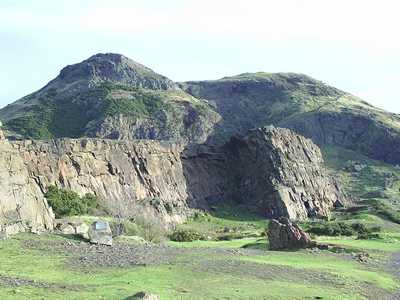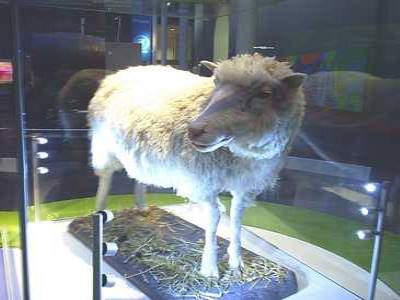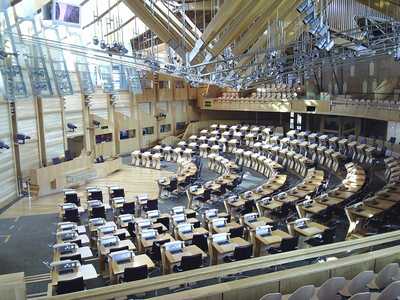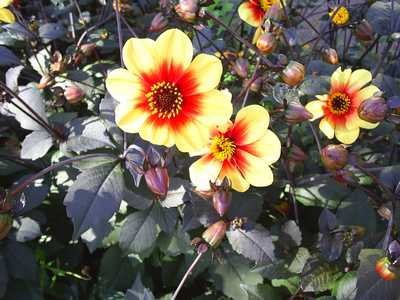Attractions
Edinburgh CastlePalace of HolyroodhouseEdinburgh Museums and GalleriesThe Scottish ParliamentEdinburgh ZooRoyal Botanic GardenOur Dynamic EarthFestivals and EventsEdinburgh Ghost ToursNelson MonumentRoyal Yacht BritanniaEdinburgh MapEdinburgh QuizLinksPalace of Holyroodhouse
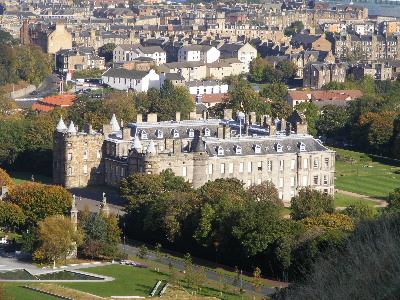
Holyroodhouse from Salisbury Craggs
The Palace of Holyroodhouse is located at the bottom of Edinburgh's Royal Mile and is the official residence of His Majesty The King in Scotland.
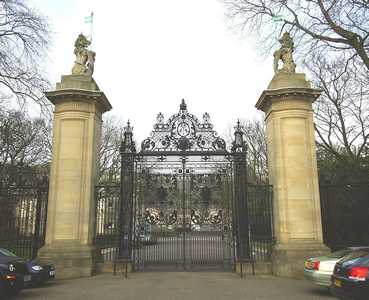
Ornamental gates
History
The earliest parts of the building date from the late 15th century and the Palace was gradually extended over the years. The tower to the left of the main entrance, for example, predates that to the right. This can best be seen by comparing the weathering of the stonework on each. The stonework of the older tower to the left is dark and rough while the newer tower to the right is bright and smooth.
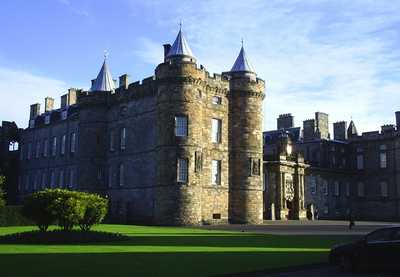
Enjoying a magnificent setting next to Holyrood Park and Arthur's Seat, Holyroodhouse has provided the stage for many important historical events in Scotland's past.
The Palace is built next to the ruins of Holyrood Abbey which was founded in 1128.
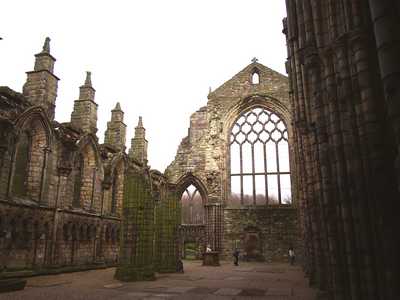
Holyrood Abbey
The Abbey itself was built over the spot where King David I is said to have experienced a miracle when out hunting one day. Separated from his companions a magnificent hart (a male red deer or stag) appeared out of the mist, frightening his horse and throwing him to the ground. As the animal closed in to attack, the King instinctively put out his hands for protection. At this point a cross is said to have miraculously appeared between its antlers. This stopped the hart in its tracks and it turned and fled in terror. That night in a dream the King was commanded to build a holy house on the site. This he did, and that building was Holyrood Abbey.
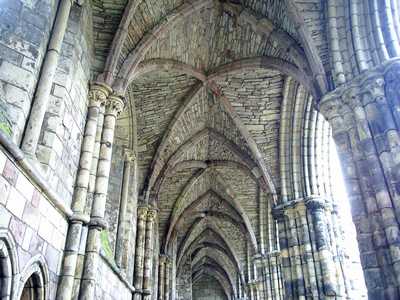
Vaulted ceiling of side aisle
Later, around 1500, James IV built the first proper Palace on the site, replacing the former guesthouse that had been built close by the Abbey and which had become the residence of earlier Scottish kings. The new Palace was built around a quadrangle, containing the Royal Apartments, Great Hall and a Chapel.
In 1544 Henry VIII of England despatched an army under the Earl of Hertford to burn Leith and sack Edinburgh to show his contempt at the refusal of the Stuarts to marry Mary to his son. This resulted in considerable damage to the Palace.
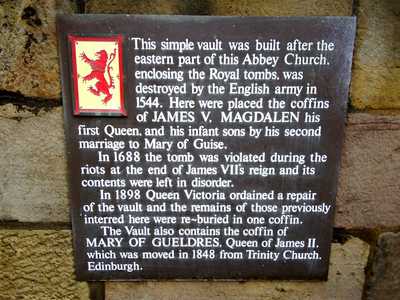
Plaque
Later, in 1650, when Oliver Cromwell was visiting Edinburgh, the Palace was burned by his troops. Although Cromwell rebuilt the Palace, shortly after this it was torn down again and rebuilt in 1671 by Charles II, in essentially its present form. The nave roof was vaulted in stone, but collapsed in 1758 shortly after being built.
Mary Queen of Scots
Perhaps the most famous inhabitant of the Palace was Mary Queen of Scots.
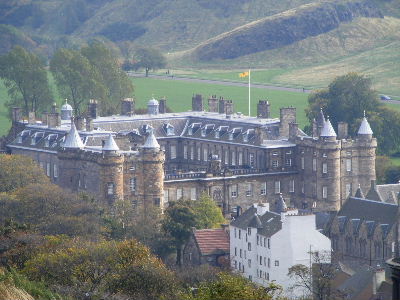
The Palace from Calton Hill
Born in 1542, Mary was the daughter of King James V of Scotland. James died within a week of her birth and Mary was crowned Queen of Scots before her first birthday.
Aged five, Mary was sent to Paris be raised in the French court under the terms of an arranged marriage to Henri II's son, Francois. Mary was said to have been very popular in the French court and excelled in languages and the arts. On Henri's death in 1559, Francois succeeded to the French throne with Mary becoming his Queen Consort. Tragedy struck however only a few month's later when Francois died of an ear infection.
Mary, by this time a highly cultured and beautiful young woman, returned to Scotland in 1561, aged just 19. Holyrood Palace became her new home, but unfortunately she returned to Scotland at a time of enormous political and religious upheaval and her involvement in this would eventually to lead to her downfall.
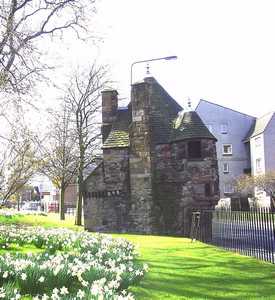
Bathhouse of Queen Mary
She married Henry Stuart Lord Darnley at Holyrood Palace in 1565. This antagonised Elizabeth I of England who felt threatened by Mary'ss Catholic background and potential claim to the English throne.
One of the most famous incidents concerning Mary was the murder in 1566 of her private secretary, a handsome Italian by the name of David Rizzio. Darnley had become jealous of the high regard in which Mary held Rizzio and arranged a conspiracy to murder him. This was carried out in front of Mary and Rizzio was reputed to have been stabbed 57 times.
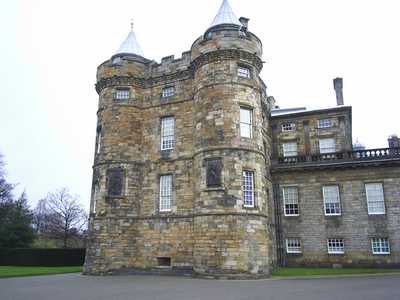
Mary's bedroom was on the second floor
A year later Darnley, convalescing from illness, was found dead ina huge explosion at Kirk O' Field in Edinburgh. It is thought he had been murdered prior the explosion. Mary who had meantime become increasingly close with the Earl of Bothwell was eventually forced to abdicate and was subsequently transferred into English hands. She was held prisoner from 1568 - 1587, before being charged with conspiracy to murder Elizabeth in 1586. Found guilty, she was executed by beheading at Fotheringhay Castle in Northamptonshire in 1587.
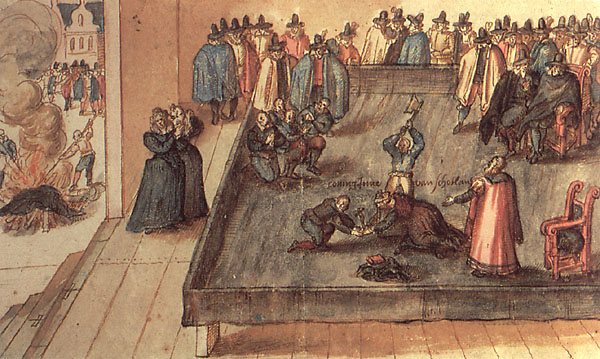
The Execution of Mary Queen of Scots at Fotheringhay Castle
(Copyright note - this image is reproduced from Wikipedia, the free encyclopedia, on the basis that that it is now in the public domain for the reasons stated on that website.)
In 1603, Elizabeth died and Mary's only son, James VI , became James I of England. James became the first King of both Scotland and England.
Mary's body was buried in Westminster Abbey and a replica of her tomb can be seen at the National Museum of Scotland in Chambers Street, Edinburgh.
The Palace today
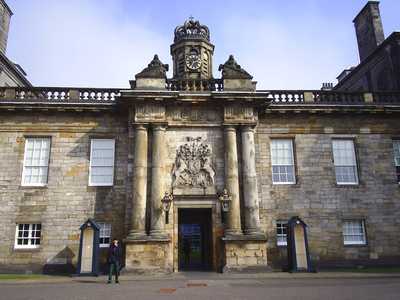
Main entrance
Because the Palace of Holyroodhouse is the The King's official residence in Scotland it is very much a working Royal Palace. Visitors must therefore anticipate the possibility of some degree of disruption arising from Royal visits, ceremonies or functions. For example, each year The King takes up residence at the Palace for a week during July. This is known as Holyrood Week, when he undertakes a number of official engagements, including hosting the Royal Garden Party when around 8,000 of the great and the good are invited to take tea and cake.
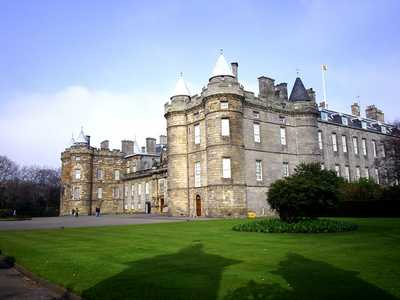
View of towers
When the King is in residence the Royal standard is flown above the Palace. When he is not in residence the Lion Rampant is flown.
